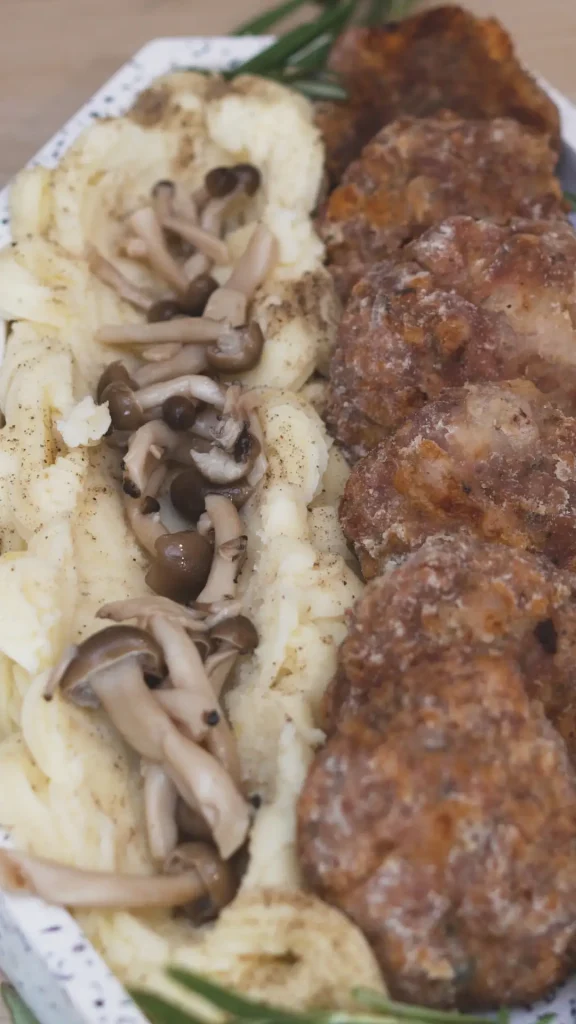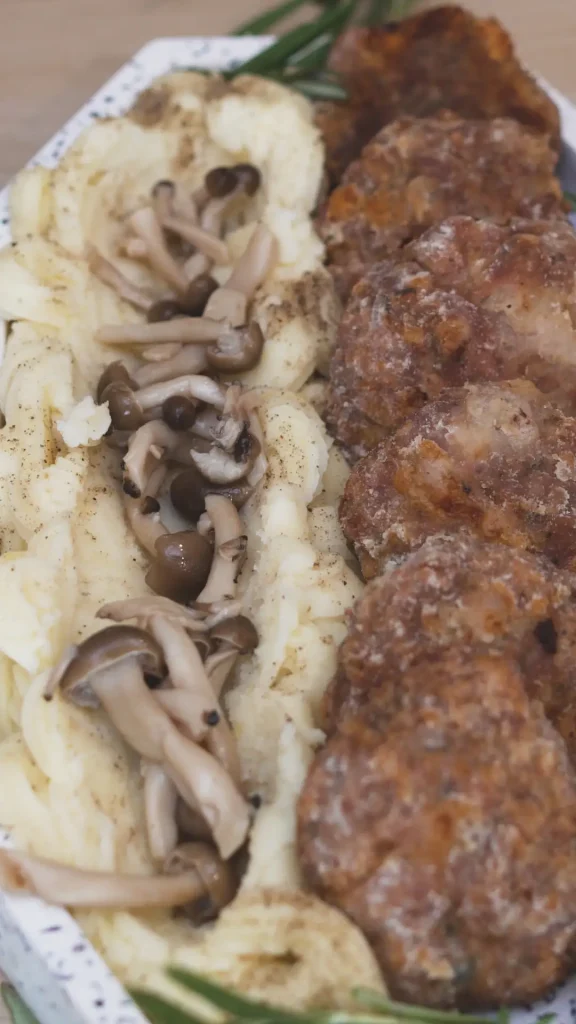Introduction to Mint Meatballs
What Makes Mint Meatballs Unique?
While mint may not be a common ingredient in traditional meatball recipes, it adds a unique and refreshing flavor that sets mint meatballs apart from their counterparts. The combination of savory meat and bright, herbaceous mint creates a delightful contrast that tantalizes the taste buds.Mint is often associated with Greek and Middle Eastern cuisines, where it is used liberally in various dishes. In Greek meatballs, mint is combined with other herbs like parsley and oregano to create a flavorful base for the meat.The use of mint in meatballs is not limited to any particular cuisine, however. Recipes for mint meatballs can be found in various cultures, each with its own unique twist. Some recipes call for a combination of ground beef and lamb, while others use turkey or chicken.One of the key factors that makes mint meatballs unique is the way the mint is incorporated into the recipe. Fresh mint leaves are typically finely chopped and mixed into the ground meat, ensuring that each bite is infused with the herb’s flavor. Some recipes also call for adding mint to the cooking liquid or sauce, further enhancing the mint flavor throughout the dish.


Ingredients You’ll Need
- 500 grams of mixed minced pork and beef
- 1 medium onion(3-4 shallot), finely chopped
- 1/2 cup fresh mint leaves, finely chopped
- a slice of bread (Panko for extra crunch)
- 1 large egg
- 1 tablespoon chili powderцги
- 1 teaspoon salt
- 1/2 teaspoon black pepper
Preparation Steps
- heat the oven to 200 degrees
Mixing the Meatball Mixture
- Prepare the Mixture: In a large mixing bowl, combine the ground lamb and beef (or pork), chopped onion, minced garlic, chopped mint, parsley (if using), breadcrumbs, Parmesan cheese (if using), egg, oregano, salt, and black pepper. Mix everything together gently with your hands until well combined.


Shaping the Meatballs
How to Form Perfect Meatballs
- Shape the Meatballs: Scoop about 2 tablespoons of the meat mixture and roll it into a ball. Place the meatballs on a plate or directly on the lined baking sheet. Continue until all the mixture is used.


- Adjusting Flavor: Feel free to adjust the amount of mint based on your personal preference. If you love mint, add more for a stronger flavor!
Watch the Video Tutorial
Cooking Methods for Mint Meatballs
Baking for a Healthier Option
- Bake the Meatballs: Transfer the seared meatballs to the prepared baking sheet. Bake in the preheated oven for about 20 minutes, or until the meatballs are cooked through and no longer pink in the center.
Serving Suggestions
- Serving Suggestions: These mint meatballs are versatile! Serve them with pita bread,mashed potatoes, over pasta, or in a wrap for a delicious meal.

Creative Ways to Serve Mint Meatballs
- Serve: Remove the meatballs from the oven and let them rest for a few minutes. Serve them warm, garnished with additional mint or parsley if desired. They pair wonderfully with tzatziki sauce, rice, or a fresh salad.

Storing and Reheating Leftovers
How to Store Mint Meatballs Properly
- Storage: Leftover meatballs can be stored in an airtight container in the refrigerator for up to 3 days or frozen for up to 3 months.
A Brief History of Meatballs
Meatballs are a culinary delight that transcends borders and cultures, bringing people together over a shared love for flavorful bites of ground meat. From ancient Rome to modern kitchens worldwide, the evolution of meatballs tells a fascinating story of cultural exchange, innovation, and adaptation. Let’s take a friendly stroll through the rich history of meatballs and discover how this beloved dish has become a staple in various cuisines.
Ancient Origins: The Birth of Meatballs
The journey of meatballs begins in ancient civilizations, with the earliest known recipes tracing back to ancient Rome. The Roman cookbook Apicius, dating from the 4th or 5th century, showcases several varieties of meatballs, known as polpette. These early meatballs were not limited to beef; they included ingredients like chicken and even cuttlefish, seasoned with a medley of herbs and spices. This versatility reflects the sophisticated palates of the Romans and their penchant for culinary experimentation[1].
However, the concept of meatballs likely extends beyond Roman borders. The Persian dish known as kofta is another early contender in the meatball lineage. Made from minced meat mixed with rice or lentils, kofta was shaped into balls or cigars and traveled along ancient trade routes, influencing various regions, including Greece, North Africa, and Spain. The Arabs added their flair by glazing their meatballs with egg yolk and saffron, introducing rich flavors that would resonate through Mediterranean cuisines[2].
The Global Spread of Meatballs
As trade routes flourished, the meatball concept spread across continents, adapting to local ingredients and culinary traditions. By around 200 BC, meatball-like recipes began appearing in China, where they were often made from pork and incorporated into soups and stews. This adaptability highlights the universal appeal of meatballs, demonstrating their ability to fit into diverse cooking methods and flavor profiles[1].
In Europe, each region developed its own unique take on meatballs. For instance, Swedish meatballs, known as köttbullar, are typically made from a blend of beef and pork, seasoned with nutmeg and allspice, and served with creamy gravy and lingonberry sauce. Meanwhile, in Italy, meatballs, or polpette, are often smaller and served as a standalone dish, sometimes in a light broth rather than with pasta[3][5].
The Italian-American Connection
The iconic spaghetti and meatballs dish that many associate with Italian cuisine actually has its roots in the United States. In the late 19th and early 20th centuries, waves of Italian immigrants brought their culinary traditions to America. Faced with economic hardship, these immigrants creatively used affordable ingredients like ground meat and canned tomatoes to create hearty meals for their families. This adaptation led to the beloved spaghetti and meatballs, which has since become a staple of Italian-American cuisine, even though it’s rarely found in traditional Italian restaurants[4][5].
Cultural Significance and Modern Variations
The history of meatballs is not just a tale of ingredients; it’s also a reflection of cultural identity and adaptation. Nearly every major culture has its own version of meatballs, from Spanish albondigas to Chinese lion’s head and South African skilpedjies. This global presence underscores the meatball’s accessibility and versatility, making it a dish that can be enjoyed by anyone, anywhere.
Today, meatballs continue to evolve, with chefs experimenting with different meats, spices, and cooking methods. From vegan meatballs made with lentils and chickpeas to gourmet versions featuring exotic spices and sauces, the possibilities are endless.
Conclusion
Meatballs are more than just a delicious dish; they are a testament to culinary creativity and cultural exchange throughout history. From their ancient origins in Rome and Persia to the modern adaptations we see today, meatballs have captured the hearts and taste buds of people around the world. So next time you enjoy a plate of meatballs, take a moment to appreciate the rich history and the many cultures that have contributed to this timeless dish. Whether served with spaghetti, in a sandwich, or on their own, meatballs will always have a special place at the dining table.
Variations on Mint Meatballs
Vegetarian Alternatives
Vegetarian Mint Meatballs Keto Recipe
Ingredients:
- 1 cup cooked chickpeas (or use lentils for a variation)
- 1/2 cup rolled oats (or breadcrumbs for binding)
- 1/4 cup fresh mint (chopped)
- 1/4 cup fresh parsley (chopped)
- 1 small onion (finely chopped)
- 2 cloves garlic (minced)
- 1 tsp ground cumin
- 1 tsp ground coriander
- 1 egg or flax egg (for vegan: mix 1 tablespoon ground flaxseed with 3 tablespoons water and let sit for 5 minutes)
- Salt and pepper to taste
- Olive oil for frying or baking
Instructions:
- Mash the chickpeas: Start by mashing the cooked chickpeas in a large bowl until they are mostly smooth but still have some texture. Alternatively, you can use lentils for a slightly different base.
- Mix in the ingredients: Add the chopped mint, parsley, onion, garlic, oats (or breadcrumbs), cumin, coriander, salt, and pepper. Stir everything together until well combined.
- Add the binder: Mix in the egg or flax egg, which will help bind the mixture together. If the mixture feels too wet, add a little more oats or breadcrumbs. If it’s too dry, you can add a splash of olive oil or a bit of water.
- Shape the meatballs: Form the mixture into small balls (about the size of a golf ball) and place them on a plate.
- Cook the meatballs:
- Option 1: Pan-fry the meatballs in a little olive oil over medium heat, turning them occasionally until they are browned on all sides and firm to the touch.
- Option 2: Bake the meatballs on a parchment-lined baking sheet at 375°F (190°C) for 20–25 minutes, turning them halfway through, until golden brown.
- Serve: These vegetarian mint meatballs pair beautifully with a yogurt dipping sauce (use a plant-based yogurt if you’re keeping it vegan), tahini sauce, or a simple tomato-based sauce. They also work great over a bed of couscous, rice, or in a pita wrap with fresh veggies.
Mediterranean Mint Lamb Meatballs
- When you think of the Mediterranean, vibrant flavors and fresh ingredients often come to mind, and lamb pairs beautifully with mint. This version of mint meatballs highlights Mediterranean herbs and spices to create a savory and fragrant dish.
- Ingredients:
- Ground lamb
- Fresh mint (chopped)
- Garlic
- Onion (finely chopped)
- Ground cumin
- Ground coriander
- Lemon zest
- Feta cheese (optional)
- Instructions: Mix the ground lamb with garlic, onion, chopped mint, cumin, coriander, and a bit of lemon zest to brighten the flavors. For extra richness, add crumbled feta cheese. Shape the mixture into small meatballs and fry them in olive oil until browned and cooked through. Serve with a dollop of tzatziki or hummus and a side of couscous or tabbouleh for a full Mediterranean experience.
Asian-Inspired Mint Pork Meatballs
- Mint might not be a common herb in traditional Asian cooking, but it adds a unique touch when combined with the right flavors. In this variation, ground pork is used as the base, and the mint is balanced with fresh ginger, soy sauce, and a hint of spice.
- Ingredients:
- Ground pork
- Fresh mint (chopped)
- Ginger (grated)
- Soy sauce
- Garlic
- Red chili flakes or fresh red chilies
- Scallions (chopped)
- Sesame oil
- Instructions: Combine ground pork with ginger, garlic, chopped mint, soy sauce, and a pinch of red chili flakes for heat. Scallions add a touch of sweetness and freshness. Shape into meatballs and fry or bake them until cooked through. Serve these mint pork meatballs with steamed rice and a side of stir-fried vegetables, or place them in lettuce wraps with a drizzle of hoisin sauce for a delightful appetizer.
Minty Meatball Skewers with Yogurt Dipping Sauce
- For a fun and creative way to serve mint meatballs, try turning them into skewers! This version incorporates a blend of beef and lamb (or chicken for a lighter option) with fresh herbs, garlic, and a tangy yogurt sauce that complements the minty flavor perfectly.
- Ingredients:
- Ground beef, lamb, or chicken
- Fresh mint (chopped)
- Parsley (chopped)
- Garlic
- Onion powder
- Ground cumin
- Paprika
- Greek yogurt
- Lemon juice
- Cucumber (grated)
- Instructions: Mix the meat of your choice with mint, parsley, garlic, and a blend of spices like cumin and paprika. Shape into slightly elongated meatballs, thread onto skewers, and grill or roast them until nicely browned. Serve with a yogurt dipping sauce made from Greek yogurt, lemon juice, grated cucumber, and a bit of garlic. These skewers are perfect for a summer barbecue or as a fun appetizer at your next gathering.
Vegetarian Mint Meatballs
- For those who prefer a plant-based option, mint meatballs can still be part of your menu. Using chickpeas, lentils, or a combination of beans, these vegetarian mint meatballs are packed with protein and flavor.
- Ingredients:
- Cooked chickpeas or lentils (mashed)
- Fresh mint (chopped)
- Breadcrumbs or oats
- Garlic
- Onion (finely chopped)
- Ground cumin
- Ground coriander
- Egg or flax egg (for binding)
- Instructions: Mash the chickpeas or lentils and mix them with garlic, onion, chopped mint, and spices. Add breadcrumbs or oats for texture, and use an egg or flax egg as a binder. Form the mixture into meatballs and bake them until golden and firm. Serve with a minty tahini sauce, or pair them with a tomato-based sauce and serve over rice or pasta for a hearty vegetarian meal.
Mint Meatballs with Pomegranate Glaze
- For a sweet and savory twist, pomegranate molasses can take mint meatballs to the next level. This Middle Eastern-inspired version uses ground beef or lamb paired with fresh mint, and the pomegranate glaze adds a tangy sweetness that’s irresistible.
- Ingredients:
- Ground beef or lamb
- Fresh mint (chopped)
- Onion (finely chopped)
- Garlic
- Ground cinnamon
- Ground cumin
- Pomegranate molasses
- Honey
- Lemon juice
- Instructions: Mix the meat with onion, garlic, chopped mint, cinnamon, and cumin. Form into meatballs and sear them in a pan until browned. In a small saucepan, simmer pomegranate molasses, honey, and a touch of lemon juice until it thickens into a glaze. Pour the glaze over the meatballs and serve with rice or pita bread. The combination of the savory meatballs and the sweet-tangy glaze is a flavor explosion in every bite.
Nutritional Information
Health Benefits of Mint
Mint is more than just a breath freshener; it offers numerous health benefits. It aids digestion by relaxing the muscles in the digestive tract, helping to ease bloating and indigestion. Mint’s anti-inflammatory properties, attributed to compounds like rosmarinic acid, can alleviate symptoms of seasonal allergies. The menthol in mint serves as a natural decongestant, potentially easing respiratory issues. Furthermore, mint is abundant in antioxidants, which promote overall health by combating oxidative stress in the body.
Caloric Breakdown of Mint Meatballs
The calorie content of mint meatballs varies based on the ingredients used. For instance, a serving of traditional lamb mint meatballs typically contains around 250–300 calories for 4 meatballs. This includes protein from the lamb, which tends to be higher in calories and fat but is also rich in essential nutrients like iron and vitamin B12. If you choose a leaner protein such as ground chicken, the calorie count decreases to about 180–220 calories per serving.
For a vegetarian option made with chickpeas or lentils, you can expect approximately 150–180 calories per serving. The addition of fresh mint, herbs, and spices contributes minimal calories, making mint meatballs a healthy, low-calorie meal choice that still packs a flavorful punch.
Common Mistakes to Avoid
Overmixing the Meatball Mixture
One of the most frequent mistakes when making meatballs is overmixing the ingredients. If you mix the meat and herbs too vigorously, you risk breaking down the meat’s fibers, leading to tough, dense meatballs. To prevent this, gently combine the ingredients until they are just mixed, ensuring that the mint, spices, and other components are evenly distributed without overworking the meat. The aim is to keep a tender and juicy texture.
Not Cooking Thoroughly
Another common issue is undercooking or unevenly cooking the meatballs. Whether you’re frying, baking, or grilling, it’s essential to make sure your meatballs are fully cooked, especially when using meats like lamb, beef, or chicken. Use a meat thermometer to verify an internal temperature of 165°F (74°C) for poultry and 160°F (71°C) for beef or lamb. If you’re preparing plant-based or vegetarian meatballs, ensure they are cooked until firm and golden brown on the outside to maintain their shape and provide a satisfying texture.
Can I Freeze Mint Meatballs?
Yes, you can definitely freeze mint meatballs! Freezing is an excellent way to prepare them in advance or save leftovers for a quick meal later. To freeze, first cook the meatballs as you normally would and allow them to cool completely. Next, arrange them in a single layer on a baking sheet and freeze until solid. Once frozen, transfer the meatballs to an airtight container or freezer bag. They can be stored in the freezer for up to three months. When you’re ready to enjoy them, simply reheat the meatballs directly from frozen by baking them in the oven at 350°F (175°C) for about 20–25 minutes, or until they are heated through.
How Do I Know When They’re Done?
The most reliable way to ensure your mint meatballs are fully cooked is to use a meat thermometer. For meat-based meatballs, the internal temperature should reach 165°F (74°C) for chicken or 160°F (71°C) for beef or lamb. This ensures that the meat is completely cooked and safe to eat. If you don’t have a thermometer, you can also check by cutting into a meatball—there should be no pink in the center, and the juices should run clear. For vegetarian or vegan versions, the meatballs should feel firm to the touch and have a golden brown exterior, indicating they are cooked through and have the right texture.



